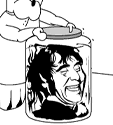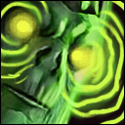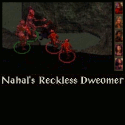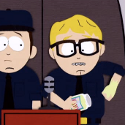|
goldjas posted:The 4e Monster Vault and all books after it literally had an entire page of lore for each monster type, then a page or two of nothing but statblocks of different types of that monster (orc, orc chief, orc shaman, for example), I thought it was a pretty cool approach to this, basically having a page you could ignore if you didn't give a drat about fluff, and pages you could ignore if you didn't want to read about the stats but want to really know all about Beholders or something. I'm really at a loss here, because "spontaneous" generation of sentient creatures from the earth is so incredibly dumb, I could never suspend disbelief. Personally, if you cannot handle writing around your PCs having to "kill babies" I'm not sure what to say, because that seems fairly easy to me unless you're intending to create difficult moral dilemmas or you're fine with the "magical springing from the Eartth" answer. In any case, this whole conversation just showcases for me the following issue, which is the canonical nature of published fluff. I've always used it as a creative tool, to be harnessed for interesting idea or whatnot and dispensed with if you don't like it.
|
|
|
|

|
| # ? Jun 11, 2024 18:14 |
|
Eh, spontaneous generation of sentient creatures form the earth or whatever doesn't make any less sense to me then, yknow, loving zombies or dragons and magic actually existing. I actually like weird things like that, it makes more sense in a way that most things would not, in fact, work like real life.
|
|
|
|
MadScientistWorking posted:Actually, it depends. 4E's world building typically surpassed anything that 2E could ever squeak out because at its best it was incredibly hyper directed to the point where I'm sure more has been written about zombies and undead in 3E/4E books than anything 2E could ever hope for. Admittedly, this did result in the problem that you would effectively have Monster Manuals dedicated to an entire class of creatures such as demons, dragons, and undead which would limit their appeal but still it actually was a pretty good book. Nah, this isn't true. There was a ridiculous amount of detail published during the 2E era regarding everything. I once read a long Dragon article on flinds-- not gnolls, just flinds by themselves. There were tons of soft splats covering every little monster niche and heaps of detail in various setting and world guides on top of the detailed MC and MM entries. And it's wrong to disregard all the ecology stuff. Sure it's basically interesting toilet reading, but interesting toilet reading often provides the inspiration for cool adventures and encounters. Let's not get overzealous in our praise of 4E. Sure it is the most mechanically sound and clearly presented edition, but it's not without its faults; and sparse, boring monster fluff was one of its big ones. It didn't bother me all that much, but that's largely due to the massive catalog of AD&D era fluff I could fall back on when I wanted it. goldjas posted:The 4e Monster Vault and all books after it literally had an entire page of lore for each monster type, then a page or two of nothing but statblocks of different types of that monster (orc, orc chief, orc shaman, for example), I thought it was a pretty cool approach to this, basically having a page you could ignore if you didn't give a drat about fluff, and pages you could ignore if you didn't want to read about the stats but want to really know all about Beholders or something. The MV was definitely great and a clear shift away from the problems with earlier monster books in 4E, but its pages were half the size of those earlier books and only one book followed it and its model.
|
|
|
|
ZombieLenin posted:I'm really at a loss here, because "spontaneous" generation of sentient creatures from the earth is so incredibly dumb, I could never suspend disbelief. The same people who came up with the whole Fire/Air/Earth/Water thing also came up with spontaneous generation of life. In fact, for some variants on both it was the same person. One is perfectly fine. The other is incredibly dumb. What is the dividing line? That one has a history of having been in D&D?
|
|
|
|
To be honest with stats what like 4E gave it's monsters you could pretty much figure out almost all you needed to know from the stat block alone though, which was a pretty good strength of 4E that I think other Editions of the game lack, for instance, in 2E or even 3E, whats the difference between orcs, goblins, kobolds, and bugbears if you don't describe what it looks like or look at it's picture? The answer is not much, a few more hit points here and a bigger damage dice there really. I think this point has already been made in this thread though. Then again I'm one of those people who would not have been sad if a Monster Manual was just straight up stat blocks and pictures with no fluff text at all, so I may be in the minority in thinking that.
|
|
|
|
ZombieLenin posted:I'm really at a loss here, because "spontaneous" generation of sentient creatures from the earth is so incredibly dumb, I could never suspend disbelief. Personally, if you cannot handle writing around your PCs having to "kill babies" I'm not sure what to say, because that seems fairly easy to me unless you're intending to create difficult moral dilemmas or you're fine with the "magical springing from the Eartth" answer. I really like the idea of monsters as somehow being former humans who have been cursed or diseased or the results of magical modification or something, like orcs being humans who a wizard warped into enhanced soldiers, or turning into a gnoll is something you do after you die if you were especially wrathful in life. I think spontaneous generation can work within a very deep dungeon that already borders on other dimensions, but it does feel weird to me on a larger campaign scale.
|
|
|
|
Spontaneous generation as a result of magical, primordial, or extradimensional corruption (really, take your pick of adjectives) makes a lot of sense actually, and many settings (including D&D) use it in some form or another. Peter Jackson just went ahead and said "You know what? Orcs are made of mud. Deal with it."
|
|
|
|
Honestly this seems like something which actually would be good for a 'module' approach. Orcs, goblins, bugbears etc. may be mechanically similar in all incarnations but some summary can provide the DM with hook-laden options and some comments on what tone would be good, ranging from "spawned from corrupt earth" if you just want humanoid swarms all the way up through re-enacting Warcraft if you want a campaign arc or B-plot. e: I know this uses up PageCount but in a hypothetical Monster Manual you would probably be giving these guys a bit more space than green jellies and black puddings anyway. My own preferred approach is that orcs are like fantasy Klingons: they may not be nice (by your standards) and if you run into them in the Gladeshire you can probably expect they're up to something, but they're reasoning beings with whom discourse and cooperation is possible.
|
|
|
|
|
If the goal is to provide GMs with hooks to use rather than something to just sit and read when they're bored then giving monsters "multiple choice" backgrounds honestly makes a lot more sense than trying to set down the "definitive" ecology of the kobold or the otyugh or whatever.
|
|
|
|
goldjas posted:To be honest with stats what like 4E gave it's monsters you could pretty much figure out almost all you needed to know from the stat block alone though, which was a pretty good strength of 4E that I think other Editions of the game lack, for instance, in 2E or even 3E, whats the difference between orcs, goblins, kobolds, and bugbears if you don't describe what it looks like or look at it's picture? The answer is not much, a few more hit points here and a bigger damage dice there really. I think this point has already been made in this thread though. This point was made once or twice before, but it bears repeating a hundred time over. I should be able to describe any monster in the game having only been exposed to its mechanics, without the aid of any fluff. It's the gaming expression of "Show, don't tell." Sure, the 3E Monster Manual might tell me that Kobolds are sneaky and orcs are brutal, but the 4E Monster Manual actually shows me that. So then, when the players encounter a monster that they've never seen before (out of character) they can still understand a ton about that monster just by fighting it. Then, there's no need to make a DC 30 Knowledge check or have the DM do an infodump, the nature of the monster is self evident.
|
|
|
|
J. Alfred Prufrock posted:This point was made once or twice before, but it bears repeating a hundred time over. I should be able to describe any monster in the game having only been exposed to its mechanics, without the aid of any fluff. This isn't "lore" in any sense and "the monster is sneaky" is something I struggle to recall any version of D&D failing to get across in either stat blocks or fluff. Also, if all the lore can be turned into single line bullet points, it's really loving lame lore. Best to save the space and write nothing at all at that point, at which point we get to the rub of the problem. There's no practical difference between a book that a player/DM can actually enjoy in his spare time and a book with good lore. Probably the best monster manual I own is the 3e Iron Kingdoms Monsternomicon, which tends to spend 2-3 pages talking about even 1/2 HD bug monsters. For every monster, you will get a complete in-universe opening story, lore skill checks, adventure hooks, any special tactics the creature might use, any notable monetary value of its various body parts, bodily fluids, or items, and advice on how to work the creature as a PC, where applicable. And oh yeah, habitat/ecology stuff. Just off the top of my head. I again struggle to imagine the player whose Real Game Experience was damaged by the size of these monster entries. It doesn't always serve the game well to reduce everything to a bunch of technical bullet points to improve "ease of use." This stuff where we have to decide how sterile a monster entry (or any lore) should be is, thank god, not a problem many other games have.
|
|
|
|
Kai Tave posted:Let me clarify something; I agree that monsters ought to come with hooks. I'm not really interested in a book that's literally 100% statblocks. I do. I started trying to run 4e recently and constantly ran into problems of 'I don't know what these guys do.' Like a kobold, I thought they were dog men or something? Like hyenas. Do they worship dragons, that was kinda in that one video game I played. How do their tribes work? What do they hang out with? Do people think poorly of them? This information is super useful to me. They're orks, what does that mean? Are they tolkien orks? So they are just always bad guys for evil doom army person? Are they warhammer 40k orks where they are plant and act like soccer hooligans who also have space magic? Are the warcraft orks where they act like the noble savage? Give me something to work with, I dont NEED to use it but give me background information on how this stuff works so I don't need to invent all this stuff. I had a player want to find out what the natural predators for a fire beetle was. I mean yea its not super important but I couldn't come up with a natural predator of a giant fire breathing beetle. Little pieces of information like this to help me explain whats going on without doing a ton of prep time or stuff that helps me improvise a lot easier. I have never played dnd before, it makes it really hard to come up with the reasons behind everything when all you need to do is write half a page up on how a species operates and throw that in. Bonus points because you can make plot hooks out of it. 4e MM are garbage. They are hugely unhelpful for actually making a game. kingcom fucked around with this message at 02:04 on Jul 9, 2013 |
|
|
|
goldjas posted:To be honest with stats what like 4E gave it's monsters you could pretty much figure out almost all you needed to know from the stat block alone though, which was a pretty good strength of 4E that I think other Editions of the game lack, for instance, in 2E or even 3E, whats the difference between orcs, goblins, kobolds, and bugbears if you don't describe what it looks like or look at it's picture? The answer is not much, a few more hit points here and a bigger damage dice there really. I think this point has already been made in this thread though. I really liked the 4E monsters for how different they were in fights, but that's just one facet of their existence as game elements. J. Alfred Prufrock posted:This point was made once or twice before, but it bears repeating a hundred time over. I should be able to describe any monster in the game having only been exposed to its mechanics, without the aid of any fluff. This is quite extreme I think. There is so much more to the game than mechanical interactions. Monsters should be mechanically distinct, but that shouldn't be the only way they're distinct. A whole lot of narrating ("telling") goes on during a D&D game and it's no less important or a part of the experience than the mechanical "showing". Really, "show, don't tell" is a poor maxim for anything outside of an undergrad creative writing class because the point isn't "don't tell", it's "you probably tell too much and should show more", or in other words, "learn when you should show and when you should tell". PeterWeller fucked around with this message at 01:15 on Jul 9, 2013 |
|
|
|
kingcom posted:4e MM are garbage. They are hugely unhelpful for actually making a game. That's a really strong statement. I've observed you fretting about making encounters for your 4e game; 4e monster manuals provide that in a way that's quicker, easier, and way more comprehensive to implement than any other version of D&D I've seen. I wouldn't trade that for yet another story about how goblins are rear end in a top hat scavengers.
|
|
|
|
Kai Tave posted:If the goal is to provide GMs with hooks to use rather than something to just sit and read when they're bored then giving monsters "multiple choice" backgrounds honestly makes a lot more sense than trying to set down the "definitive" ecology of the kobold or the otyugh or whatever. I would agree with this. If you're holding an adventure in a volcano and want FIRE SPIDERS then you don't have to flip through thirty books trying to find the Lesser Spotted Flame Arachnid, you just look at the hook section that says "spiders in elemental regions: here are some suggestions about how they would work" or whatever.
|
|
|
|
ZombieLenin posted:I'm really at a loss here, because "spontaneous" generation of sentient creatures from the earth is so incredibly dumb, I could never suspend disbelief. OTSP posted:I think spontaneous generation can work within a very deep dungeon that already borders on other dimensions, but it does feel weird to me on a larger campaign scale. Al-Ghazali posted:Moreover, we have seen genera of animals that are spontaneously generated from earth and are never procreated - as for, example, worms - and others like the mouse, the snake, and the scorpion that are both generated and procreated, their generation being from the earth. Their dispositions to receive forms differ due to things unknown to us," That's way more interesting than "5d10 Goblin Children (Alignment: NE)" which is something I actually saw in a 2e book last week. How does generation from the earth work? Why do some generated things become orcs and others goblins? That's a hell of adventure hook. I don't see how spontaneous generation is any more difficult to suspend disbelief for than any other thing our ancient ancestors believed, like people exist that have the heads of dogs. Mormon Star Wars fucked around with this message at 01:22 on Jul 9, 2013 |
|
|
|
Evil Sagan posted:That's a really strong statement. I've observed you fretting about making encounters for your 4e game; 4e monster manuals provide that in a way that's quicker, easier, and way more comprehensive to implement than any other version of D&D I've seen. I wouldn't trade that for yet another story about how goblins are rear end in a top hat scavengers. I ended up giving up and using the monster vault for that. Thats super helpful, gives me an explanation of what, where and useful encounters rather than the magnificent 8 kobold minions encounter. EDIT: For reference I was talking about the monster manuals themselves they improved when they went on to the monster vault style.
|
|
|
|
Evil Sagan posted:That's a really strong statement. I've observed you fretting about making encounters for your 4e game; 4e monster manuals provide that in a way that's quicker, easier, and way more comprehensive to implement than any other version of D&D I've seen. I wouldn't trade that for yet another story about how goblins are rear end in a top hat scavengers. The 4E MMs do provide the best tools for making encounters. But they provide poo poo for contextualizing those encounters. Honestly, that's a problem throughout early 4E-- the focus on encounters instead of adventures. Consider the chat about the delve format that was happening a few pages back.
|
|
|
OneThousandMonkeys posted:This isn't "lore" in any sense and "the monster is sneaky" is something I struggle to recall any version of D&D failing to get across in either stat blocks or fluff. What almost seems like it could work better is if they classed monsters by broad types and gave each a few pages, which would include core statistic blocks so you can just go 'OK, an orc band with a shaman leader, fight 'em' but included discussion of ways to implement them and perhaps hooks and ideas on how to use the particular assets of that kind of creature. Actually provide some discussion and practical examples of how kobolds or goblins are 'tricky,' that kind of poo poo.
|
|
|
|
|
ZombieLenin posted:I'm really at a loss here, because "spontaneous" generation of sentient creatures from the earth is so incredibly dumb, I could never suspend disbelief. Personally, if you cannot handle writing around your PCs having to "kill babies" I'm not sure what to say, because that seems fairly easy to me unless you're intending to create difficult moral dilemmas or you're fine with the "magical springing from the Eartth" answer. It's significantly less dumb than the idea that you have what effectively amounts to a subspecies of humanity that is biologically drawn towards acts of violence and evil, yet manages to restrain said psychotic impulses in order to raise kids, establish settlements, and generally kill time between random murderfests. Also that this race of people is so inherently sociopathic and violent that babies fresh outta some green wombs are filled with such hateful thoughts in their squishy little brains that don't even understand basic concepts like object permanence. Hateful, evil little babies that are just fine to kill because if you let them grow up, they'll just be as evil and as nasty as their dead parents because of the biological urge to be grade-A murderous assholes. Except when they don't, story hooks notwithstanding. I'm not saying that every monster in the world has to rise up out of the ground like those screaming skeletons from Jason and the Argonauts. They can occur in a number of ways, like guys doing war crimes being punished by the gods, or the shadows of dead murderers coming alive. I went with "emerging from the soil" as my go-to example because it was in LotR and it had a long pedigree of crazy medieval-and-earlier mythology behind it. And again, because it doesn't involve the loving ludicrous concept of born-evil babies. At any rate, it's no less dumb than the entire concept of wizards in general.
|
|
|
|
PeterWeller posted:The 4E MMs do provide the best tools for making encounters. But they provide poo poo for contextualizing those encounters. Honestly, that's a problem throughout early 4E-- the focus on encounters instead of adventures. Consider the chat about the delve format that was happening a few pages back. I'm not going to disagree with this. I'm also not really understanding why a player needs to know what the natural predators of the giant fire beetle are, why the character would have that knowledge, why it would come up in the first place. Given that they need to know, they have a way of knowing, and it's important that they know, I don't understand why the DM (or player) didn't just say "velociraptors" or "land sharks" or "giant crows" or "it has no natural predators, they all mysteriously caught fire thousands and thousands of years ago" and then go with that.
|
|
|
|
AlphaDog posted:I'm not going to disagree with this. My player wanted to use prestidigitation to make the noise of the predator to scare a pack of them away. I ended up going 'loving dragons' because i figure every creature in dnd has that as a predator. It was clever, he got to trivialise the encounter because of that. It just little stuff like that is nice to know. I like monsters to have a bunch of information about them so i can cherry pick what I find cool/interesting in it to use in my game.
|
|
|
|
OneThousandMonkeys posted:This isn't "lore" in any sense and "the monster is sneaky" is something I struggle to recall any version of D&D failing to get across in either stat blocks or fluff. 4e does it nicely by giving monsters shifts in all the right places. Showing, not telling - but it requires first setting up a language to get the monster's movement right, then getting the monster right. kingcom posted:I dp. I started trying to run 4e recently and constantly ran into problems of 'I don't know what these guys do.' Like a kobold, I thought they were dog men or something? Like hyenas. Do they worship dragons, that was kinda in that one video game I played. Kobolds revere dragons. ... Kobold Lore DC 15: Kobolds often dwell near a dragon's lair, maintaining a safe distance but bringing sacrificial offerings to their 'god'. quote:How do their tribes work? "There are nine and sixty ways of constructing tribal lays, "And every single one of them is right!" They aren't all cookie-cutter monsters. Any more than all human tribes work the same way. quote:What do they hang out with? Other than dragons? Fire beetles, stirges, scorpions, dire rats, rat swarms, guard drakes, needlefang swarms, spitting drakes. All from the encounter groups. In short affinity for domesticating lizards - but also anything else nasty they can control. quote:Do people think poorly of them? Kobolds bully what few weaker creatures they can find and are bullied by everything else. So yes. quote:This information is super useful to me. And every last bit of it, except asking how the tribes work, is in the MM1. Now I accept that the MM1 is designed for easy reference at the tablet rather than reading on the throne when you are constipated. But when every last scrap of information you have claimed is super-useful is there other than asking all kobold tribes to work the same way, I have little sympathy. Edit: kingcom posted:My player wanted to use prestidigitation to make the noise of the predator to scare a pack of them away. I ended up going 'loving dragons' because i figure every creature in dnd has that as a predator. It was clever, he got to trivialise the encounter because of that. It just little stuff like that is nice to know. I'd consider information like that in the MM for me would have literal negative value. It's something stupid to be memorised as a DM if it's there - and assumes things about the ecology. (Adventurers are the natural predator for anything FWIW). On the other hand, I expect to be able to come up with a decent answer on the spot - if someone gets their nature check right. (If they don't I may come up with a comedy answer). neonchameleon fucked around with this message at 02:00 on Jul 9, 2013 |
|
|
|
Spiced rum with apple-lime juice is pretty good.
|
|
|
|
AlphaDog posted:I'm not going to disagree with this. Some people would rather have these details provided for them, especially because providing these details may inspire them towards new adventure hooks. You don't have to use these bits of fluff, but they're there for you if the PCs start coming up with some scheme to use the goblins' pet fire beetles to lure some remorhazes into the drow city. It makes DMing easier by doing some of the work for you. And of course, at your table you are free to ignore it. It can also help you develop your own adventures. I like all the ecology and society stuff, for example, because it gives me a workable and logical explanation for why all these different monsters are in this one cave complex. I could come up with that stuff on my own, but I'd rather be thinking of reasons why the PCs want to go to that cave. I don't see a reason why we have to choose either good statblocks or detailed fluff passages. The 4E statblock isn't any longer than the AD&D one, and the Monster Manual has a statblock, picture, and detailed fluff section for every monster.
|
|
|
|
This was in regards to Kai_Taves post. I was specifically quoting what was in that book actually... My point was that this stuff is infinitely useful and I want those kinds of entries for all the monsters. I used kobolds as an example of questions to ask because that has the actual information im looking for. I'm not sure what your point is exactly. Are you agreeing with me that those should be in there more? Are you just trying to argue that the MM1 isn't bad? I
|
|
|
|
OneThousandMonkeys posted:This isn't "lore" in any sense and "the monster is sneaky" is something I struggle to recall any version of D&D failing to get across in either stat blocks or fluff. Without looking at the spoilers, tell me which of these is a Goblin and which is a Kobold, and why. "3.5 Monster Manual posted:Kobold, 1st-Level Warrior "3.5 Monster Manual posted:Goblin, 1st-Level Warrior How different are these two monsters in play?
|
|
|
|
kingcom posted:This was in regards to Kai_Taves post. I was specifically quoting what was in that book actually... I'm arguing that it's a vastly underrated book. That there's a lot more in the MM1 (including different approaches various monsters have to the world - the individual statblocks presented are important) than is usually given credit for. And because I want to make the Goblin vs Kobold point even more clearly, of these two, one is a goblin minion and the other is a kobold minion. I've stripped everywhere their statblocks overlap with the 3.x statblock because I'm lazy. Monster Vault posted:Trait: Sniper Monster Vault posted:Minor action: Shifty I doubt that there is a single 4e player in this thread who can't tell which of those is which. Despite both being slippery bastards, they are slippery in different ways. And slippery in ways that no previous version of D&D showed. Edit: There's one meaningful difference between the 3.5 goblin and kobold stats. Kobolds are light sensitive. Also they are slightly weedier than goblins - 4hp rather than 5. How different they are in play depends on whether you use sunrods to blind kobolds when attacking them. Edit 2: Apparently Dazzled is only actually -1 penalties, so even that isn't a meaningful difference in (RAW) play. neonchameleon fucked around with this message at 02:35 on Jul 9, 2013 |
|
|
|
neonchameleon posted:I'm arguing that it's a vastly underrated book. That there's a lot more in the MM1 (including different approaches various monsters have to the world - the individual statblocks presented are important) than is usually given credit for. Right, I have very little frame of reference for other versions of dnd. The stuff you've describe is what I expect by default. I don't want a monster because its a stat block or a cool ability etc. I want a monster because there's a story that involves them or they would combine really well with something else or give me an idea for something else. The Kobold entry mostly does it well, I disagree that there is enough of what I want. Give me a list of things that are cool/unique about the race so i can make a plot about it. See from the shifty trait, I got a completely different impression from kobolds, I used them to always get extra movement with their shift, so they bolted up to their opponents and were really good at swarming them. It was less running and more being able to bound in a pack after a target and all leap on it. I mean yea, thats cool but it doesn't mean I want fluff stuff to be removed/minimised by default. EDIT: I do want to know how kobolds set up. If kobolds love gold for dragons, I can do a setting about how kobolds are working as road guards so the local population give them a fee to keep the lands safe for merchants. Giving me one bit of information lets me extend on that or take the idea in a different direction. kingcom fucked around with this message at 02:55 on Jul 9, 2013 |
|
|
|
It might also be interesting to see how they are handling the pair in Next.next posted:Goblin next posted:Kobold It's like a blend of pre-4e sameness in the actual stats, and 4e style unique traits. One of these monsters swarms you, the other sneaks around and stabs you in the back. They are also doing a bit of the 4e-style 'noun noun' monsters, like 'kobold alchemist' that throws bombs.
|
|
|
|
Nessus posted:While I broadly agree with you, I'll point out you're talking about a single integrated campaign setting (Iron Kingdoms) where presumably you are in it for the Iron Kingdoms flavor primarily. There is no reason someone could not have a wholly legitimate D&D game where the goblins spring out of the earth and all of that and have it fit perfectly in with everything else; that just is not Iron Kingdoms. Well, if I the DM ignore an entry's fluff in whole or in part, the game isn't causing me any harm. We're already operating under a game system where it's generally expected that stuff is going to get selectively used--hence "modular" D&D, which has always been a thing on just about every level of the game, including fluff. Just because the game is meant to be modular does not mean the designers are "free" from an obligation to ever write anything at all compelling. And, again, even in 4E, they are still writing all kinds of fluff! Reams of it! You're just better served by never reading the majority of it, because it's stupid. When we do read it, we all tend to come to the conclusion that the fluff is, by intention or error, supposed to be inconsequential. So it comes down to "Uh, this poo poo sucks" or hand-waving it as "setting-neutral." There is at least one thing that happens when the designer writes a bunch of interesting fluff under his 1/2 HD bugs, though. It sets a standard of quality. I don't really blame anyone who thumbs through the monster manual from the core set and goes "this is WoW video game babby poo poo." I know people who like 4E who have reached similar conclusions about what the game's focus is. Let's go back to Bear Facts. This really needs to be re-posted, in my opinion, because it sounds like some people are really running away from the fact that yes, 4E does have lore. It's not setting-neutral, it's just terrible, is all:  This is probably the most infamous one, but most of the lore is like this. Which leads to this fairly weird (to me) attitude of "Well I don't want any lore if it's just going to be the same old orc lore!," which sounds to me like a tunnel-vision view of how any of this is supposed to be done. J. Alfred Prufrock posted:Without looking at the spoilers, tell me which of these is a Goblin and which is a Kobold, and why. I know which one is which because I know the system a little too well and know those stat blocks, and that is about the only reason; but because I have basic system mastery, I can also tell you that they each have a +4 to Hide. Sneaky. Not very sneaky, mind, but on average sneakier than a monster of the same approximate CR. I wasn't arguing that 4E mechanics don't differentiate creatures better or matter more, though. If we want to get really pedantic, the goblin and kobold monster racial abilities in 4E aren't actually very different. Name Change fucked around with this message at 03:13 on Jul 9, 2013 |
|
|
|
Wait, that's a Next monster with a mechanical advantage for being with 5' of a target, but they don't recommend using miniatures in Next?
|
|
|
|
OneThousandMonkeys posted:If we want to get really pedantic, the goblin and kobold monster racial abilities in 4E aren't actually very different. One's an action, one's a reaction. I know, equally pedantic, but you'd be surprised how big of an impact just a simple change like that can make. A Kobold can't react to a Defender's attempts at blocking it by slipping to the side after dodging its clumsy sword-swing. Meanwhile, a Goblin can't charge you, attack, and then scramble back before you even get a chance to swing at them. The former lends itself much better to the swarms and stealth associated with Goblins, while the latter lends itself very well to the Kobold standbys of traps and ambushes.
|
|
|
|
That is actually on par with AD&D fluff though of which almost the same exact information is communicated through five paragraphs.quote:This is probably the most infamous one, but most of the lore is like this. Which leads to this fairly weird (to me) attitude of "Well I don't want any lore if it's just going to be the same old orc lore!," which sounds to me like a tunnel-vision view of how any of this is supposed to be done. MadScientistWorking fucked around with this message at 03:38 on Jul 9, 2013 |
|
|
|
victrix posted:Wait, that's a Next monster with a mechanical advantage for being with 5' of a target, but they don't recommend using miniatures in Next? Next defines melee range as 5'.
|
|
|
|
In defense of Bear Lore, what the gently caress else could they say about bears?
|
|
|
|
OneThousandMonkeys posted:This is probably the most infamous one, but most of the lore is like this. Which leads to this fairly weird (to me) attitude of "Well I don't want any lore if it's just going to be the same old orc lore!," which sounds to me like a tunnel-vision view of how any of this is supposed to be done. I think a good monster description needs a few lines of basic physical description (which 4e did a pretty good job of before the Lore check fluff blobs), but the whole point of having anything more intensive than that is to give seeds of inspiration to the DM. The descriptions don't need to flesh anything out in detail, but they should have something interesting about them that the DM wouldn't necessarily default to if forced to improv--something beyond 'they live in tribes and are violent'. The Next ettercap description was really good for this--it was fairly short and to the point, but the whole spider-farming pixie-dust-eating schtick is something that can help inspire a new DM to use them in a more interesting manner. If I had 5 minutes to prepare an ettercap-themed session with no more info than 'they're spiderish' even just a little bit of 'they actively try to reclaim settled land and revert it to nature. . .but in a creepy sort of way' would go a long way towards getting my creative juices pumping. That said, having too much info about monsters is a pain in the rear end to remember. I do like that each of the facts mentioned in the Next example have their own little paragraph with a bolded intro-summary. Edit: Brother Entropy posted:In defense of Bear Lore, what the gently caress else could they say about bears? Real-world animals are tough. You could always throw a few sample ideas about their relationships with other fantastic creatures, though--how they often aid dryads in defending their forests, or how bears killing livestock might be a sign that a much more dangerous type of monster-predator might have moved in nearby and forced them out of their usual hunting grounds. OtspIII fucked around with this message at 04:04 on Jul 9, 2013 |
|
|
|
Let's compare the 4e and 3e kobold fluff, rather than statblocks and mechanics. 4e MM1: Introductory paragraph posted:Kobolds revere dragons and tend to dwell in and around places where dragons are known to lair. They skulk in the darkness, hiding from stronger foes and swarming to overwhelm weaker ones. Kobolds are cowardly and usually flee once bloodied unless a strong leader is present. Kobolds like to set traps and ambushes. If they can't get their enemies to walk into a trap, they try to sneak up as close as they can and then attack in a sudden rush". Then each subtype has a paragraph describing how they will fight, then... 4e MM1: Kobold Lore posted:DC15: Kobolds often dwell near a dragon's lair, maintaining a safe distance but bringing sacrificial offerings to their "god". Most dragons ignore kobolds, as a crocodile ignores birds that pick its teeth clean. Once in a great while, however, a young dragon takes an interest in its kobold cult, which then becomes a real menace to the dragon's enemies. 3e MM1: Kobold posted:<some stuff describing the creature's appearance> Then one short paragraph about how they fight, then 3e MM1: Kobold society posted:Kobolds live in dark places, usually underground locations and overgrown forests. They are good miners and often live in the mines they are developing. A kobold tribe sends out warbands that patrol within a 10 mile radius from the lair, attacking any intelligent creatures that enter their territory. Kobolds usually kill prisoners for food but occasionally sell some of them as slaves. Their nasty habits and their distrust of most other beings mean they have many enemies. 4e kobolds are dragon-worshippers who bring sacrifices to dragons, who usually just ignore them as a resource/army. The live in dark places near dragon lairs and use traps to catch sacrifices for their dragon-god. They skulk around and usually flee if bloodied (that is, they have lost 50% of their HP), but a strong leader will prevent that. 3e kobolds are nasty little humanoids who hate everyone else and have lots of enemies. They live in mines or forests and use traps to catch people they either eat or enslave. They roam around the countryside and attack every intelligent being if they outnumber them at least 2-1 (except gnomes, who they hate). If they don't outnumber the foe 2-1 at any point, they usually run away (except from gnomes, who they hate). The 3e version takes more than twice as many words to say the same amount of things about kobolds. It still manages to have fewer interesting parts or any adventure hooks beyond "evil race, takes slaves, eats people". Next would not be harmed by having more of the "1 egg per 10 adults" stuff if that's what people want, as long as it doesn't use that as a word-count excuse to not say anything interesting or creative. Elector_Nerdlingen fucked around with this message at 04:10 on Jul 9, 2013 |
|
|
|
AlphaDog posted:words Since i brought it up I just want to reinforce that im not saying other editions were better etc. I just am stating what I want out of a monter listing.
|
|
|
|

|
| # ? Jun 11, 2024 18:14 |
|
kingcom posted:Since i brought it up I just want to reinforce that im not saying other editions were better etc. I just am stating what I want out of a monter listing. Yeah, I get that. It's just that it's useful to compare the 3e and 4e versions of things directly side-to-side like this. 4e usually has better mechanical stuff for monsters, and we've been over that a few times in this thread. The fluff/ecology stuff is usually presented as "4e has none/little", but I don't think that's true. In some cases (bears) the fluff is pretty stupid in 4e. In others, such as the kobold, the 4e fluff is arguably better / more useful even though it leaves out a lot of "basic" information like how many miles from their lair they will patrol and how many young/eggs are in the lair. 3e says some stuff about kobold ecology and society (what they eat, they lay eggs, they hate gnomes, they take slaves, etc), while 4e provides something interesting ideas for adventures (they catch people and sacrifice them to their dragon-god, who usually ignores them. If he ever stops ignoring them, they're going to get really dangerous). Ideally, Next would contain both of these things. 3e claims to do this, but has lots of "they patrol <10> miles from their <forest> lair and hate <gnomes>" instead of interesting bits. As far as bears go, what are you gonna say about bears that's interesting? Put a stat block on a page of "animals, normal" and call it good. Everyone knows what a bear looks like (a bear), eats (picanick baskets), and whether or not they poo poo in the woods (80% chance, 95% if the current pope is catholic). If any monsters use bears as horses or dogs or blankets, say so in the description of that monster, not in the description of the bear where most people will never find it when they're looking for a cool monster to use. If you want to have a race of bear-people or bear-dragons or bear-zombies or bear-owls, or whatever else that's sorta kinda bear-like but does something interesting, then make it its own entry separate from bears. Elector_Nerdlingen fucked around with this message at 04:52 on Jul 9, 2013 |
|
|































